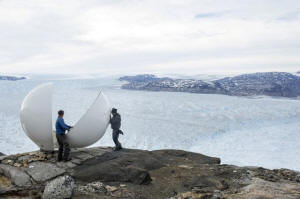|
Greenland and the hunt for better climate
science
 Send a link to a friend
Send a link to a friend
 [September 19, 2018]
By Alister Doyle, Elizabeth Culliford and Lucas Jackson [September 19, 2018]
By Alister Doyle, Elizabeth Culliford and Lucas Jackson
GREENLAND (Reuters) - Flying over eastern
Greenland, the NASA scientists stared down from a Gulfstream jet as it
followed the precise course they had flown in previous years - using
radar to map the loss of ice.
“In the tube,” flight engineer David Elliott said as the team locked
into their route over the ice sheet covering 80 percent of the world’s
largest island. Out the window, massive chunks of broken ice looked like
salt flakes on the water.
The March mission was part of NASA’s Oceans Melting Greenland (OMG)
project, a five-year, $30 million effort aimed at improving sea level
rise projections by understanding how warming oceans are melting ice
sheets from below - the most ambitious research on the subject to date.
Rising seas threaten low-lying cities, islands and industries worldwide.
But projections for how high and how soon the rise will come vary wildly
in part because scientists lack clarity on how fast warming oceans are
melting polar ice sheets. The uncertainty confounds the preparations of
governments and businesses and fuels the arguments of climate-change
skeptics.
(For additional stories, graphics and videos from the Project Greenland
interactive series, see: https://tmsnrt.rs/2xvdzOS )
A draft report by the United Nations’ Intergovernmental Panel on Climate
Change (IPCC), for example, predicts that seas are likely to rise
between 33 centimeters and 1.33 meters by 2100 - a wider range than the
28-to-98 centimeters estimate in the last IPCC assessment from 2013.

The IPCC projections, which were reviewed by Reuters, have not been
previously reported.
Until now, most glacier research has focused on how warming air melts
ice sheets, but warming oceans play a crucial role, said OMG’s principal
investigator, Josh Willis.
“It’s not just an ice cube and a hair dryer,” he said, offering an
oft-used metaphor for how warmer air melts glaciers. “We’re really just
beginning to grapple with how these ice sheets are going to behave in a
warming world.”
The OMG project aims to clarify how Greenland itself contributes to
rising seas, but also to apply that knowledge to the study of the much
larger region of Antarctica, which has far more ice and could ultimately
play a much bigger role in sea-level rise. And while most of Greenland's
ice is on land above sea level, large parts of the Western Antarctic ice
sheet are below sea level, making them more vulnerable to warming
oceans.
Melting ice in Greenland currently adds 0.8 millimeters of water to
global ocean levels annually, more than any other region, according to
NASA. That’s enough water to fill 115 million Olympic-sized swimming
pools.
Scientists authoring the IPCC study, expected to be the most
authoritative sea-level assessment to date, declined to discuss the
preliminary findings on the record. Hans-Otto Poertner, a leader of the
IPCC report, said the document will be “subject to review and further
revision” before its planned release in September 2019.
The forecast range for sea-level rise, however, is unlikely to get more
precise, one scientist working on the draft said on condition of
anonymity.
“The range for sea level rise is getting wider,” the scientist said.
HOLES IN THE DATA
Better projections would be invaluable to governments worldwide.
Britain’s Environment Agency, for instance, foresees upgrades to a
barrier on the Thames River to protect London against 90 centimeters of
sea level rise by 2100, but could modify the plans to account for a
catastrophic 2.7 meters.
One 2017 study published by U.S. scientists in a journal of the American
Geophysical Union estimated a rise of 50 centimeters by 2100 would
submerge land that is now home to about 90 million people, mainly in
China, Vietnam and Bangladesh. A rate of 1.5 meters would swamp the
homes of more than 150 million people worldwide, the study estimated.

A 2016 study published in a journal of the U.S. National Academy of
Sciences predicted that an event comparable to Superstorm Sandy, which
flooded large swaths of the New York region in 2012, would be up to 17
times more likely by 2100 if seas rise by 1 meter.
Higher seas are already creating more dangerous storm surges, the IPCC
says, exacerbating flooding or coastal erosion from the U.S. Gulf Coast
to the Maldives to China. Some low-lying island nations, such as Fiji
and Vanuatu, have moved some coastal communities to higher ground.
The IPCC draft says that the rate of sea level rise in 2100 will depend
heavily on the effectiveness of governments in reducing fossil fuel
pollution, which the U.N. panel says has been the dominant cause of
global warming since the mid-20th century.
But holes in scientists' understanding of ice sheet dynamics also make
it difficult to predict how glacier melt will contribute to rising seas,
said David Holland, a New York University oceanographer who has studied
Greenland’s glaciers for 12 years.
[to top of second column]
|

Safety officer Brian Rougeux works with student Febin Magar to
assemble a radar dome while working in a science camp on the side of
the Helheim glacier near Tasiilaq, Greenland, June 20, 2018.
REUTERS/Lucas Jackson

“The modeling of it is like Swiss cheese,” Holland said. “It’s
getting into the more challenging projections and unknown physics.”
DEEPER, WARMER WATERS
Some of Greenland’s glaciers are disappearing more rapidly than
others, and understanding why is a key goal of NASA’s mission.
New NASA data on water temperature, depth and salinity has helped
explain why the rate of ice loss at northwestern Greenland’s Tracy
glacier is almost four times the rate of the nearby Heilprin
glacier. That’s because the fresh water flowing from Tracy, which
sits on deeper bedrock, is mixing with a layer of warm, salty water
off Greenland’s coast, accelerating the melting process, the
researchers found.
Many more Greenland glaciers are in similar trouble. Researchers
discovered last year that 67 glaciers were connected to the warmer,
deeper layer at least 200 meters below sea level – at least twice as
many as previously known.
In June, an iceberg four miles wide broke away from Greenland’s
Helheim Glacier and cracked into pieces in a process called calving,
an event that can be caused by warming oceans. Scientists worry that
calving will happen on a disastrous scale in Antarctica, where the
much larger Thwaites glacier, for instance, is believed to be a
linchpin holding back the West Antarctic ice sheet.
“If the Thwaites was to behave in the way of Helheim, we have no
idea" how fast it could erode, said Robert DeConto, who is a
professor of geosciences at the University of Massachusetts-Amherst
and a member of the IPCC team producing the sea-level rise report
expected next year.
The IPCC draft suggests that Antarctica alone could contribute up to
half a meter of sea level rise this century and cites increasing
evidence that the process may be irreversible.

SOUNDING THE ALARM
The importance of glacier change for global sea-level rise this
century was not widely grasped in the scientific community until
recently. In 1995, the IPCC’s second assessment said “little change
in the extent of the Greenland and Antarctic ice sheets is expected
over the next 50–100 years.”
By 2007, it said new data showed “losses from the ice sheets of
Greenland and Antarctica have very likely contributed to sea level
rise over 1993 to 2003” but did not factor in future ice-sheet melt
because of a lack of published research.
“In the beginning people thought, ‘let’s just assume that those
things are stable’,” said climate scientist Gavin Schmidt, who
directs the NASA Goddard Institute for Space Studies. Even today, he
said, “there are very few climate models that have a credible
simulation of any kind of dynamic ice sheet behavior at all.”
The scientific uncertainty is a political problem, said Tad Pfeffer,
a professor at the University of Colorado and former IPCC author.
Skeptics including U.S. President Donald Trump attack the science of
climate change as an unproven and politically motivated attack on
fossil fuel industries, and Trump last year said he would pull the
United States out of the 2015 Paris climate agreement that includes
almost 200 nations.
"The public, especially if they are getting nudged by anti-science
views, take uncertainty as saying, ‘These scientists don't know what
they’re doing'," Pfeffer said.
(Reporting by Alister Doyle in Oslo, Norway, Elizabeth Culliford in
New York and Lucas Jackson in Greenland; Additional reporting by
Travis Hartman in Greenland and Christine Chan in New York; Editing
by Richard Valdmanis and Brian Thevenot)
[© 2018 Thomson Reuters. All rights
reserved.]
Copyright 2018 Reuters. All rights reserved. This material may not be published,
broadcast, rewritten or redistributed.
Thompson Reuters is solely responsible for this content.
 |